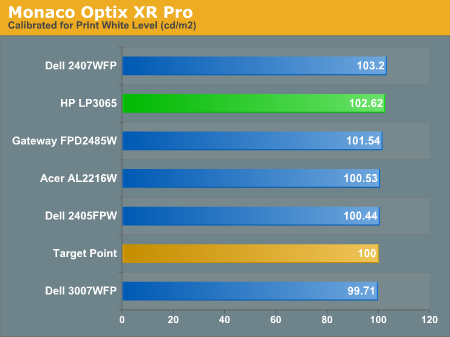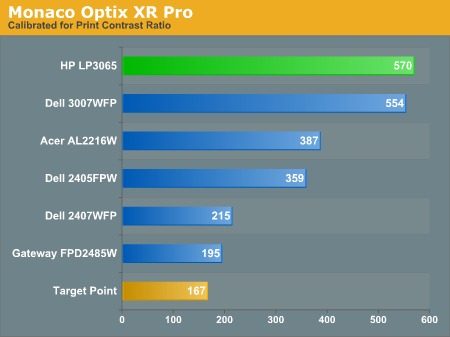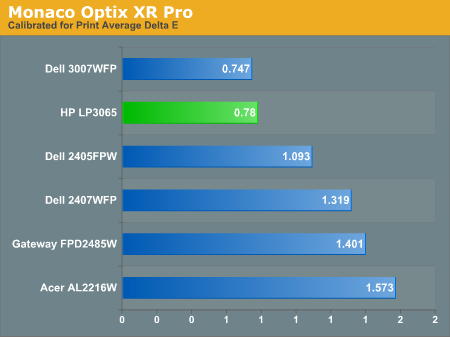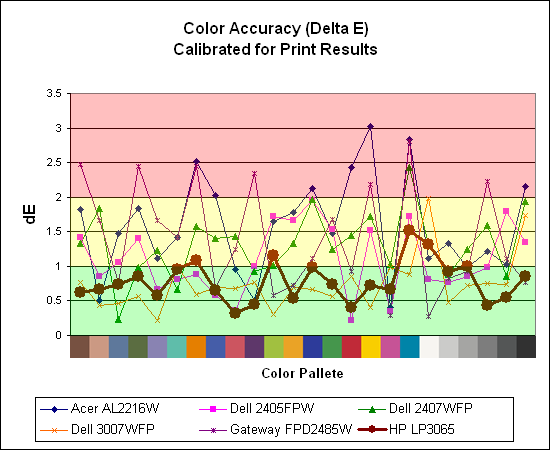HP LP3065: A new contender for the 30" throne
by Jarred Walton on March 22, 2007 7:00 AM EST- Posted in
- Displays
Printing Results
Brightness and Contrast Ratio
Using the standard calibration procedures works well if you only plan on using your computer with online data. In fact, you can generally set whatever brightness and contrast levels you want and then let the calibration software adjust the color profile as appropriate (although depending on the display certain settings will produce more or less accurate colors). However, many image professionals also have a need to match colors between their computer displays and their cameras and printers, and what works well for computing purposes often isn't the best suited for doing other image related work. To help people who work in such areas match their computer colors to their paper colors better, some standards were established. Generally speaking for print work the standard is a gamma of 2.2 (some people recommend 1.8, but we'll use 2.2), a black point of 0.60 cd/m2, and a white point of 100 cd/m2.
Finding the appropriate settings to reach these levels can be a time-consuming process. Numerous iterations through the calibration process are required in order to end up with the desired white point, and on some LCDs it might not even be possible to reach a satisfactory result. We were unable to get both an accurate white point and an accurate black point according to printing requirements (our black levels always ended up darker than they were supposed to be) but eventually we did manage to get near the desired 100 cd/m2 white point on all of the tested displays. This required adjusting the individual color levels on most of the displays, but the Dell 3007WFP and HP LP3065 lack this option so we simply reduced the brightness levels. Here are the settings we ended up using:
Dropping just the brightness on the Gateway FPD2485W and Dell 2407WFP did not reach the required white point, in the case of the former not by a long shot. We also found that dropping the brightness level to zero and then further reducing the color levels did not generate desirable results. We were most successful when we set the color levels to a moderate value and then tweaked the brightness and color levels as necessary to get the desired result. Here's how the brightness and contrast ratios changed with these tweaks.



We were not attempting to get 100% accuracy on the white point, but further tuning of the various displays would have likely made it possible to get closer to 100 cd/m2. The primary goal was to merely get the white point down to near 100 cd/m2 if possible. The target black point on the other hand is much more difficult to achieve once we have reached the target white point. Due to the reduced brightness level, contrast ratios are lower, but that is expected with print material. For reference, we have included the target values in the above graphs, so the greater the deviance of the display from the targeted value, the less suitable a display becomes for print work. Having calibrated the displays for printing, let's see how they actually fare.
Color Accuracy
Given the importance of accurate colors for printing work, we have adjusted the Delta E scale appropriately. A Delta E of less than 1.0 is definitely the goal here, and 1.0 to 2.0 is merely acceptable. Scores above 2.0 basically mean that the display is not fit for printing professionals.


The 30" displays definitely come into their own in this particular test, not only because they are far easier to calibrate (you just turn down the brightness level) but also because they score very well. The Dell 3007WFP and HP LP3065 are clearly the best displays for printing work, with very low average Delta E scores. In fact, the worst Delta E that the HP registers is only 1.52, and only five of the tested colors have a Delta E of 1.0 or more. Whether it's the overall quality of the displays or simply the S-IPS panels on the 30" LCDs, the fact is that these displays appear to be targeted more at professionals than any of the others. Considering the cost, that's probably not too surprising.
Brightness and Contrast Ratio
Using the standard calibration procedures works well if you only plan on using your computer with online data. In fact, you can generally set whatever brightness and contrast levels you want and then let the calibration software adjust the color profile as appropriate (although depending on the display certain settings will produce more or less accurate colors). However, many image professionals also have a need to match colors between their computer displays and their cameras and printers, and what works well for computing purposes often isn't the best suited for doing other image related work. To help people who work in such areas match their computer colors to their paper colors better, some standards were established. Generally speaking for print work the standard is a gamma of 2.2 (some people recommend 1.8, but we'll use 2.2), a black point of 0.60 cd/m2, and a white point of 100 cd/m2.
Finding the appropriate settings to reach these levels can be a time-consuming process. Numerous iterations through the calibration process are required in order to end up with the desired white point, and on some LCDs it might not even be possible to reach a satisfactory result. We were unable to get both an accurate white point and an accurate black point according to printing requirements (our black levels always ended up darker than they were supposed to be) but eventually we did manage to get near the desired 100 cd/m2 white point on all of the tested displays. This required adjusting the individual color levels on most of the displays, but the Dell 3007WFP and HP LP3065 lack this option so we simply reduced the brightness levels. Here are the settings we ended up using:
| Calibrated for Print Settings Gamma 2.2, White 100 cd/m2, Black 0.60 cd/m2 |
||||||
| Acer AL2216W | Dell 2405FPW | Dell 2407WFP | Dell 3007WFP | Gateway FPD2485W | HP LP3065 | |
| Brightness | 80 | 50 | 100 | 25 | 100 | 91 |
| Contrast | 80 | N/A | N/A | N/A | 100 | N/A |
| Red | 40 | 7 | 49 | N/A | 32 | N/A |
| Green | 39 | 10 | 50 | N/A | 32 | N/A |
| Blue | 39 | 11 | 46 | N/A | 32 | N/A |
Dropping just the brightness on the Gateway FPD2485W and Dell 2407WFP did not reach the required white point, in the case of the former not by a long shot. We also found that dropping the brightness level to zero and then further reducing the color levels did not generate desirable results. We were most successful when we set the color levels to a moderate value and then tweaked the brightness and color levels as necessary to get the desired result. Here's how the brightness and contrast ratios changed with these tweaks.



We were not attempting to get 100% accuracy on the white point, but further tuning of the various displays would have likely made it possible to get closer to 100 cd/m2. The primary goal was to merely get the white point down to near 100 cd/m2 if possible. The target black point on the other hand is much more difficult to achieve once we have reached the target white point. Due to the reduced brightness level, contrast ratios are lower, but that is expected with print material. For reference, we have included the target values in the above graphs, so the greater the deviance of the display from the targeted value, the less suitable a display becomes for print work. Having calibrated the displays for printing, let's see how they actually fare.
Color Accuracy
Given the importance of accurate colors for printing work, we have adjusted the Delta E scale appropriately. A Delta E of less than 1.0 is definitely the goal here, and 1.0 to 2.0 is merely acceptable. Scores above 2.0 basically mean that the display is not fit for printing professionals.


The 30" displays definitely come into their own in this particular test, not only because they are far easier to calibrate (you just turn down the brightness level) but also because they score very well. The Dell 3007WFP and HP LP3065 are clearly the best displays for printing work, with very low average Delta E scores. In fact, the worst Delta E that the HP registers is only 1.52, and only five of the tested colors have a Delta E of 1.0 or more. Whether it's the overall quality of the displays or simply the S-IPS panels on the 30" LCDs, the fact is that these displays appear to be targeted more at professionals than any of the others. Considering the cost, that's probably not too surprising.










44 Comments
View All Comments
gfisher - Sunday, July 26, 2009 - link
My HP machine has an NVIDIA 8500GT graphics card. I'm interested in buying a HP LP 3065 thirty inch monitor. Will the card drive the monitor at full speed?DaveJDSP - Sunday, December 30, 2007 - link
Jarred,I cannot possibly thank you enough for testing and posting photos of viewing angles. When doing critical photo/graphics work, it is essential that the top and bottom of the screen appear consistent from a fixed viewing point in the center of the screen. The larger the monitor, the more critical this becomes, as from a fixed point, the eyes scan over an arc of 10-20 degrees or greater.
Most monitors that I have seen at local stores have viewing angles that are totally unsatisfactory for critical work, even from a fixed eye point. And there are very few local stores that carry a sufficient selection of better and larger monitors, suitable for more critical work, so that the buyer can evaluate those monitors in person. Therefore, your complete and comprehensive reviews become even more critical.
Thank you again for your excellent reviews and for including such critical viewing angle information.
Dave
chakarov - Friday, March 23, 2007 - link
Contrast by specification shoud be 1000:1 but you measured it 585:1.It is interesting what to believe.
JarredWalton - Saturday, March 24, 2007 - link
As I explained in the Gateway FPD2485W review, contrast ratios, brightness levels, response times, and various other "spec sheet items" are often seriously exaggerated. While technically a higher contrast ratio is better, a 500:1 or higher real value is generally more than sufficient. There's also a possibility that at some specific setting the HP would come closer to 1000:1 - doubtful, given the results on the three tested settings (uncalibrated, calibrated, and print calibrated), but still possible.The basic issue is with backlight bleed - i.e. blacks that aren't actually black. In theory, any proper display would have an infinite contrast ratio, as black would be 0 and anything divided by zero is infinity/undefined. Some displays (the Acer, for example) achieve higher contrast ratios by having blacker blacks; others like the Gateway get them by having insanely bright whites. Anyway, more is not always better, as the color accuracy of the middle tones isn't represented by contrast ratio.
michal1980 - Thursday, March 22, 2007 - link
what about input lag vs a crt?crts should be the baseline since they seem to show close to 0 image lag.
lcd vs lcd is nice to, but if all lcds are off by a large number of frames from a crt, that will still suck
Souka - Thursday, March 22, 2007 - link
I feel a CRT vs LCD war thread starting..... ;)JarredWalton - Thursday, March 22, 2007 - link
LCDs are still slightly slower than CRTs, but we have abandoned the CRTs, or at least I have. I no longer have any for testing, and the last CRTs I purchased are now over two years old, the Samsung 997DF and the NEC FE991-SB. There hasn't been a new really high-end CRT released in upwards of five years, I don't think. Five or six year old 22" CRTs (with a 20" viewable diagonal) are better than the later 21/22" models in terms of features and performance. Then there's the whole geometry and signal adjustment that needs to be done on analog devices. Personally, I wouldn't even consider a CRT for my computer use anymore.Given that we have the 2407WFP for testing and it has been used already, we would prefer to continue with that trend. A baseline is just that: a reference point. Baseline doesn't have to be "best" - and obviously quite a few LCDs are better than the 2407WFP when it comes to input lag and response times. So far, however, we haven't seen more than a 1 frame (*maybe* two with the Acer AL2216W) difference in output. So the largest difference we've seen is currently less than 0.02 seconds.
Souka - Thursday, March 22, 2007 - link
Why not get a 30" Apple Cinema Display?AnnonymousCoward - Thursday, March 22, 2007 - link
Let's see, $2000 for the Apple versus $1274 for the Dell. If you like being charged up the @$$, then be my guest.Now, the Apple is competing with the LP3065 and 3007WFP-HC; those panels are superior and $300 cheaper retail. Not to mention I just bought the HC from Dell for $1430+tax. Why would you pay $570 more for a worse product?
dcalfine - Thursday, March 22, 2007 - link
YeaApple made the first 30" dual-link LCD for consumers and is often considered better than the Dell. It would be wise to consider it a contender.